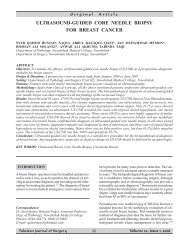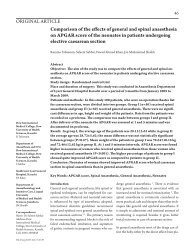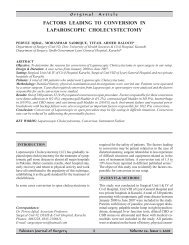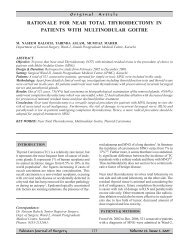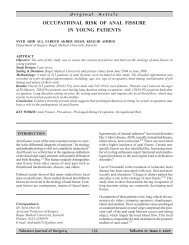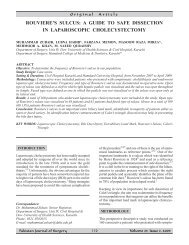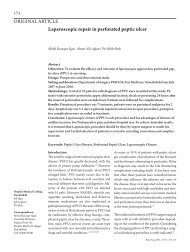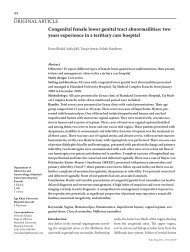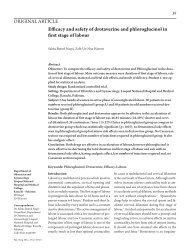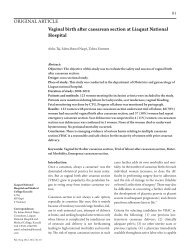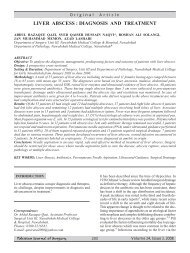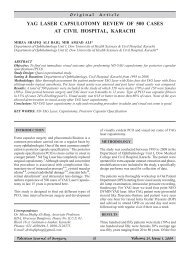AN AUDIT OF LAPAROSCOPIC CHOLECYSTECTOMY
AN AUDIT OF LAPAROSCOPIC CHOLECYSTECTOMY
AN AUDIT OF LAPAROSCOPIC CHOLECYSTECTOMY
Create successful ePaper yourself
Turn your PDF publications into a flip-book with our unique Google optimized e-Paper software.
Original<br />
<strong>AN</strong> <strong>AUDIT</strong> <strong>OF</strong> <strong>LAPAROSCOPIC</strong> <strong>CHOLECYSTECTOMY</strong><br />
SALEEM KH<strong>AN</strong>, ZAKIUDDIN G. OONWALA<br />
Department of Surgery, Hamdard University Hospital, Karachi<br />
Article<br />
ABSTRACT<br />
Objective: To evaluate the outcome of Laparoscopic Cholecystectomy in Gall stone disease, critically analyzing the<br />
complication rate, morbidity and mortality rate.<br />
Design & Duration: It is a retrospective study from June 1997 to June 2006.<br />
Setting: Hamdard University Hospital, Saifee Hospital, Burhani Hospital and Remedial Hospital, Karachi.<br />
Patients: All patients (>12 years) with cholelithiasis were included in this study. Patients with common bile duct<br />
dilatation (>8mm) or stones, or gall bladder mass or jaundice, and those declared unfit for anaesthesia were excluded.<br />
Methodology: The detailed data of all the cases was compiled and analyzed.<br />
Results: Out of the total of 1345 patients operated during the study period, 1234 (91.75%) were females and 111<br />
(8.25%) males; their ages ranged from 12 to 89 years, majority were in the age bracket of 30-50 years. Our conversion<br />
rate was 6.4%. Nine (0.67%) patients developed bleeding from the port site, 30 (2.23%) port site infection, 43 (3.20%)<br />
umbilical port hernia, two bile ducty injury and one colonic injury. There was no mortality in this series.<br />
Conclusion: Laparoscopic Cholecystectomy is a safe and effective treatment for Cholelithiasis.<br />
KEY WORDS: Laparoscopic Cholecystectomy, Cholelithiasis, Morbidity, Mortality<br />
INTRODUCTION<br />
In majority of surgical centres Laparoscopic Cholecystectomy<br />
has been accepted as the gold standard treatment<br />
for cholelithiasis. Untill recently the treatment for acute<br />
cholecystitis was conservative with antibiotics, analgesics,<br />
etc. followed by open or laparoscopic cholecystectomy.<br />
However, with increasing expertise, it has now<br />
become possible to perform laparoscopic cholecystectomy<br />
for acute cholecystitis straight away. The introduction<br />
of laparoscopic cholecystectomy and the evolution<br />
of laparoscopy has generated a new interest among<br />
general surgeons about its diagnostic capabilities 1 .<br />
We have collected the detailed data of all the cases that<br />
underwent Laparoscopic Cholecystectomy by us at different<br />
hospitals of Karachi. This study is an effort to<br />
critically analyse our results as regards to complications,<br />
morbidity and mortality.<br />
Correspondence:<br />
Dr. Saleem Khan, Associate Professor Surgery,<br />
Hamdard University Hospital, Karachi.<br />
Phones: 0333-2233631.<br />
E-mail: deshmukh_saleem@yahoo.com<br />
PATIENTS & METHODS<br />
This retrospective study was carried out at Hamdard<br />
University Hospital, Burhani Hospital, Saifee Hospital<br />
and Remedial Hospital in Karachi from June 1997 to<br />
June 2006. Patients of either sex, >12 years of age with<br />
gall stone disease were included in the study. Only those<br />
cases were excluded who had common bile duct (CBD)<br />
dilatation (>8mm in diameter) or stones, or mass in gall<br />
bladder or jaundice and those declared unfit for general<br />
anaesthesia.<br />
All patients had their blood analyzed for complete picture,<br />
urea, sugar, electrolytes, liver function tests and<br />
hepatitis B and C. All patients had an X-ray chest and<br />
ultrasound of the abdomen done. ECG was performed<br />
in cases >40 years of age.<br />
We used the standard four port technique for performing<br />
the cholecystectomy. For creating pneumoperitoneum<br />
we used the open method by appling two stay sutures<br />
in the linea alba, dividing the rectus sheath, opening<br />
the peritoneum and then placing Hasson’s cannula under<br />
direct vision.<br />
Post-operatively the patients were followed-up for six<br />
months and any complications noted. The data was then<br />
compiled and analyzed.<br />
100<br />
Volume 23, Issue 2, 2007
An Audit of Laparoscopic Cholecystectomy<br />
Saleem Khan, Zakiuddin<br />
Age Group<br />
Male<br />
Female<br />
Total<br />
Operative Finding<br />
No.<br />
%<br />
12-20 years<br />
21-30 years<br />
31-40 years<br />
41-50 years<br />
51-60 years<br />
61-70 years<br />
71-80 years<br />
> 80 years<br />
Total<br />
2<br />
15<br />
28<br />
45<br />
13<br />
4<br />
3<br />
1<br />
111<br />
15<br />
74<br />
275<br />
585<br />
210<br />
58<br />
13<br />
4<br />
1234<br />
17<br />
89<br />
303<br />
630<br />
223<br />
62<br />
16<br />
5<br />
1345<br />
Multiple gall stones<br />
Solitary gall stone<br />
Acalculus Cholecystitis<br />
Total<br />
1171<br />
165<br />
Majority of our patients went home on the first postoperative<br />
day i.e. 24 hours after admission, a minority<br />
after 48 hours and only 15 after 72 hours. Two patients<br />
who developed complications stayed for five days.<br />
9<br />
1345<br />
Table II. Operative Findings<br />
87.06<br />
12.27<br />
0.67<br />
100.00<br />
RESULTS<br />
Table I. Age Distribution<br />
Out of 1345 patients that underwent Laparoscopic Cholecystectomy,<br />
there were 1234 (91.75%) females and<br />
111 (8.25%) males, giving rise to a female to male ratio<br />
of 11:1. Majority of males and females were seen in<br />
the 4th and 5th decades of life (Table I).<br />
Majority (87%) of our cases had multiple gall stones<br />
(Table II). In 86 (6.4%) cases we had to convert to open<br />
surgery. This includes cases of cholelithiasis as well as<br />
those of acute cholecystitis. Our mean operative time<br />
was 50 minutes, the range varying from 30 minutes to<br />
110 minutes.<br />
The post-operative complications are shown in Table<br />
III, the commonest being umbilical port hernia. Of the<br />
two common bile duct injuries, one was recognized during<br />
surgery and the other on the first post-operative<br />
day. Both were dealth with by repair over a T-tube.<br />
Table III. Post-operative Complications<br />
Complication<br />
Bleeding from Epigastric port<br />
Epigastric port infection<br />
Umbilical port infection<br />
Umbilical port hernia<br />
Common bile duct injury<br />
Colonic injury<br />
Mortality<br />
No.<br />
9<br />
9<br />
21<br />
43<br />
2<br />
1<br />
--<br />
DISCUSSION<br />
Laparoscopy is becoming popular day by day, and laparoscopic<br />
surgeons are now becoming bold and exploring<br />
almost all corners of the peritoneal cavity. Laparoscopic<br />
cholecystectomy has revolutionized the treatment<br />
of cholelithiasis and it is now considered as the<br />
gold standard, because it causes less surgical trauma<br />
thereby resulting in reduced hospital stay and early<br />
resumption to normal activity 2 .<br />
No surgery can be performed without having complications.<br />
Our observation was that majority of complications<br />
were either due to the Veress needle or the 10mm<br />
sharp trochar insertion. Diziel et al 3 reported 13 cases<br />
of aortic injuries with one death. Similarly Raviaco et<br />
al 4 reported one injury to aorta and one to middle colic<br />
artery. We avoided these complication as we used the<br />
open method for creating pneumoperitoneum by appling<br />
two stay sutures in the linea alba and dividing the rectus<br />
sheath and peritoneum under direct vision, and then<br />
placing the Hasson’s cannula also under direct vision.<br />
The incidence of common bile duct injury following<br />
laparoscopic cholecystectomy had been previously<br />
shown to be higher than that after open cholecystectomy<br />
i.e. 0.6% versus 0.3% 3,5 . The incidence reported<br />
by Letwin 6 was 0.1%. Adamson 7 described the incidence,<br />
0.7% and Ahmed 8 1%. In our study the incidence<br />
of CBD injury was 0.14%.<br />
The leading cause of injury to CBD is difficulty in recognizing<br />
anatomy at the Calot’s triangle. These injuries<br />
can be prevented by adequate surgical experience, careful<br />
dissection and proper case selection 9 . We had two<br />
cases of common bile duct injury. One, recognized at<br />
the time of operation, due to over traction by the grasper<br />
at the Hartmanns pouch which resulted in the tenting,<br />
101<br />
Volume 23, Issue 2, 2007
An Audit of Laparoscopic Cholecystectomy<br />
was repaired over a T-tube. The other was detected on<br />
the 2nd post-operative day, due to biliary leakage. Relaparoscopy<br />
was performed, injury was identified and<br />
the CBD repaired using a T-tube again. Both the patients<br />
made uneventful recovery.<br />
Haemmorrhage during surgery is a well known complication<br />
in nearly every series 10 . The injury may occur<br />
during Veress needle insertion or dissection 11 . Fortunately<br />
we did not had any incidence of major bleeding.<br />
Minor bleeding did happened which was easily controlled<br />
by pressure or application of sutures.<br />
Small or large bowel can be again injured while introducing<br />
the Veress needle or 1st trochar with sharp tip,<br />
or forcible dissection while freeing adhesions, or by<br />
thermal burns 12 . Often such injury are not recognized<br />
during laparoscopic cholecystectomy, but manifest later<br />
on 13 . In our study we had one colonic injury. The large<br />
bowel was accidently caught in the stay suture during<br />
creation of the pneumoperitoneum and got traumatized<br />
while inserting Hasson’s cannula. Hence, the abdomen<br />
was opened and the small perforation found was closed<br />
primarily with no after effects.<br />
In this study 13 gall bladders were accidentally perforated<br />
while performing dissection; this was controlled by<br />
applying clips or by holding the perforation site by the<br />
grasper. After removing the gall bladder the peritoneal<br />
cavity was washed with saline.<br />
Port site minor infection occured in 30 (2.2%) cases in<br />
our study is one of the post-operative problem worth<br />
mentioning. Arain et al 14 also reported umbilical port<br />
wound infection in 1.63% cases.<br />
Umbilical port site hernia (3.2%) was one of the commonest<br />
complications in our study. Bhopal et al 13 also<br />
quoted a similar (3%) incidence in their series. To avoid<br />
this complication we are now doing layered closure of<br />
the umbilical port site wound.<br />
Table IV. Comparison of Conversion Rates<br />
Place<br />
Karachi<br />
Rawalpindi<br />
Lahore<br />
Spain<br />
Hungary<br />
Israel<br />
Author<br />
%<br />
This study<br />
6.4<br />
Bhopal et al 13<br />
2.0<br />
Rehman et al 15<br />
6.6<br />
Wolnerhanssen et al 16 9.0<br />
Bondar et al 17 28.0<br />
Elder et al 18 12.5<br />
Saleem Khan, Zakiuddin<br />
We had to resort to conversion in 86 (6.4%) cases. We<br />
usually decide about conversion in the first 15 to 30<br />
minutes after the insertion of the camera. If there is no<br />
progress or mass formation or lot of adhesions, we normally<br />
decide rather early to convert to open cholecystectomy<br />
to avoid complications. The conversion rates seen<br />
in other series are shown in Table IV.<br />
CONCLUSION<br />
Laparoscopic Cholecystectomy is a safe and effective<br />
surgical procedure for cholelithiasis. In laparoscopic<br />
centres it can be performed for acute cholecystitis. The<br />
ideal period to perform laparoscopic intervention in<br />
acute cholecystitis is the first 24 to 48 hours of onset<br />
of symptoms.<br />
REFERENCES<br />
1. Salky B. Diagnostic Laparoscopic Surgery. Laparosc<br />
Endosc 1993; 3: 132-4.<br />
2. Bhopal FG, Rai MA, Iqbal MA. A comparative study<br />
of morbidity in Laparoscopic and Open Cholecystectomy.<br />
J Surg Pak 1998; 3(3): 2-7.<br />
3. Diziel DJ, Millikan KW, Economo SG, et al. Complications<br />
of Laparoscopic Cholecystectomy. A national<br />
survey of 4292 hospitals and an analysis of<br />
77604 cases. Am J Surg 1993; 165: 9-14.<br />
4. Roviaro GC, Macioco M, Rebuffat C, Varoli F,Vergani<br />
V, Rabughino G, Sarduelli A. Complications<br />
following Cholecystectomy. J Roy Coll Surg Edinb<br />
1997; 42: 324-8.<br />
5. Straunberg SM, Hertt M, Soper NJ. An analysis of<br />
problems of biliary injury during Laparoscopic<br />
Cholecystectomy. Am J Surg 1995; 180: 101-25.<br />
6. Letwin DEM, Grotti MJ, Pauline EC. Laparoscopic<br />
Cholecystectomy: Trans Canada experience with<br />
2201 cases. Can J Surg 1992; 35: 291-6.<br />
7. Adamson S, Hansen OH, Funch-Jensen P, et al.<br />
Bile duct injury during Laparoscopic Cholecystectomy.<br />
A prospective nationwide series. Am J Surg<br />
1997; 184: 571-8.<br />
8. Ahmed MS, Syed AS, Shah STA. A prospective<br />
analysis of 100 Laparoscopic Cholecystectomies<br />
at Lahore General Hospital. J Surg Pak 1996; 12(4):<br />
136-138.<br />
9. Panpimanman S, Kanyaprasit K. Complications of<br />
102<br />
Volume 23, Issue 2, 2007
An Audit of Laparoscopic Cholecystectomy<br />
Laparoscopic Cholecystectomy and their management.<br />
Hepatogastroenterol 2004; 51(55): 9-11.<br />
10. Z’graggen K, Wehrli H, Metzger A, Beuhler M,<br />
Frei E, Klaiber C. Complications of Laparoscopic<br />
Cholecystectomy in Switzerland. A prospective 3-<br />
year study of 10174 patients by Swiss Association<br />
of Laparoscopic & Thoracoscopic Surgery. Surg<br />
Endosc 1998; 12: 1303-10.<br />
11. Usal H, Sayad P, Hayek N, Hallak A, Huie F, Ferzli<br />
G. Major vascular injuries during Laparoscopic<br />
Cholecystectomy. An institutional review of experience<br />
with 2589 procedures and literature review.<br />
Surg Endosc 1198; 12: 1303-10.<br />
12. Schrenk P, Woisetschlager R, Reiger R, Wayand<br />
W. Mechanism, management and the prevention of<br />
Laparoscopic bowel injuries. Gastrointest Endosc<br />
1996; 43(6): 572-4.<br />
13. Bhopal FG, Khan JS, Yusuf A, Iqbal W, Iqbal M.<br />
Surgical audit of Laparoscopic Cholecystectomy.<br />
J Pak Inst Med Sci 2000; 17/18: 13-19.<br />
Saleem Khan, Zakiuddin<br />
14. Arain GM, Hassan A, Randhawa MH, Malik SA.<br />
Laparoscopic Cholecystectomy and its complications:<br />
A study of 1100 cases. Pak J Gastroenterol<br />
1998; 12(1-2): 29-35.<br />
15. Rehman S, Fasih T, Ashraf M, Sultan N, Hussain<br />
A. Laparoscopic versus Open Cholecystectomy: A<br />
surgical audit. J Surg Pak 1995; 11(3): 155-7.<br />
16. Wolnerhanssen BK, Ackermann C, Guenin MO,<br />
Kern B, Tondelli P, Von Flue M, Peterli R. Twelve<br />
years of Laparoscopic Cholecystectomy: One institution’s<br />
results of a prospective trial of 4498 cholecystectomies.<br />
Chirug 2004; 76(3): 236-9.<br />
17. Bondar S, Fule A, Kelmen O, Kolonich G, Simon<br />
E, Batorfij. Laparoscopic Cholecystectomy in acute<br />
cholecystitis. Acta Chir Hungary 1999; 38(2): 125-<br />
128.<br />
18. Elder S, Qunin J, Chourih, Sabo E, Matter I, Nashe<br />
E, Schein M. Safety of Laparoscopic Cholecystectomy<br />
in a teaching service: A prospective trial. Surg<br />
Lap Endosc 1996 Jun; 6(3): 218-20.<br />
103 Volume 23, Issue 2, 2007



